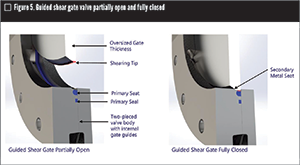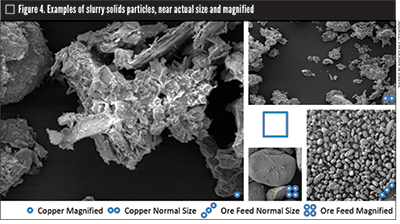Severe service involves many kinds of flow conditions and fluids, including slurries that have large concentrations of suspended solid particles. Such slurries can be extremely challenging for piping systems and especially hard on valves. This article explains slurries, the effect they have on valves and how to select or design valves for severe slurry service. Of the two types of industrial valves—control and isolation—we focus here on isolation valves.
SLURRIES: LIQUIDS WITH SUSPENDED SOLIDS
A slurry is a two-phase mixture of solid particles and liquid. Slurries are commonly encountered in mining, mineral processing and many other applications. They range from homogenous suspensions of fine, slowly settling particles to heterogeneous mixtures of coarse, more rapidly settling particles (Figure 1). Slurries can behave like water or thick paste or anything in between, depending on the solids content (Figure 2). Experts debate about how much solids content constitutes a slurry. For purposes of this article, we assume a solids content of 10% or more by weight.
- Fine particles that mix with liquid, creating a carrier fluid that has a higher density and different flow characteristics than the liquid phase
- The coarse particles suspended within the carrier fluid
Sometimes, the solids in a flow are fully or partially dissolved, but they precipitate out of solution in the pipe and valve, forming scale (Figure 3). This presents additional design challenges, including the need to size actuators large enough to deal with the scale.
ABRASIVE PARTICLES ON THE MOVE
One of the particularly challenging aspects of slurry flows is how abrasive they are. Abrasion damage occurs from solid particles striking the surfaces of valve components. This damage happens in addition to any corrosion and erosion that occurs.
The size, shape and hardness of the slurry particles (Figure 4) affect abrasion, as does the percentage of solids content. Flow characteristics also matter, including the velocity and the angle at which the slurry particles impact valve components.
SELECTING THE RIGHT VALVE FOR THE JOB
To select or design the right valves in challenging applications involving slurry flow requires drilling down to what the valves must do.
For isolation valves, think not only of the data that normally comes from suppliers about their valves—factors such as the absolute highest pressures, temperatures and media—but also what the valve is doing in the application that either helps or harms longevity of equipment service. People don’t usually pay enough attention to the valve’s operating cycle.
An isolation valve operates in two static positions: fully open and fully closed. In addition, this valve sometimes goes from one position to the other, creating a dynamic situation on opening or closing. Each condition affects wear on the valve (Table 1).
LOW-PRESSURE SEVERE SLURRY APPLICATIONS
Low pressure is a subjective term; for purposes of this article, we’ll label “low” as below ASME Class 600—below 1450 psi (10 megapascals or MPa). The most appropriate choice for isolation valves in this regime of slurry applications is the guided shear gate valve. This type of valve, invented in 1960 but still not well known, can handle all high-solids applications at these pressures, including pastes. For this service, the valve needs to be designed with elastomeric or polymeric seats and hardened body, gate and wear rings.
This type of valve is available up to ASME Class 1500. Although one of the five types of knife gate valves, in this case, the valve really is a knife gate. In fact, it is the only knife gate design that can truly cut. Figure 5 shows the guided shear gate partially open and fully closed, as well as its chisel tip.
HIGH-PRESSURE SEVERE SLURRY APPLICATIONS
For high-pressure applications—Class 600 and up—metal-seated ball valves are known to be the most effective for use with high-concentrate solids. They also can be useful down to Class 150. This is not just a floating ball valve with its Teflon seats removed and replaced with Stellite or tungsten carbide. It is a ball valve designed specifically to be a metal-seated valve. The fits, tolerances, machining, materials and design are much more challenging to produce, but these are necessary to achieve the degree of isolation tightness required.
The advantage of this valve is there is no place for the slurry to get behind the primary sealing components, which means one of the possible leak paths is eliminated.
Notice in Figure 6 on the downstream side, the ball is pushed not only by the differential pressure, but by the Belleville load spring pushing the upstream seat onto the ball and forcing the ball onto the integral seat. The ball and seat are mate-lapped together to produce a very fine seal that can be tested, even with nitrogen, to allow zero bubbles—which creates a true zero-leakage seal. Why is this important? Because if this is used with a slurry and the liquid leaks out, leaving behind the solids, the result is a plug. After that, the valve may open and close, but the process won’t move.
ACTUATORS FOR THIS KIND OF SEVERE SERVICE
Actuation for valves in severe service with slurries must be able to generate significantly higher forces than for general-purpose valves in ordinary applications. The size/capacity should be based on the worst-case conditions that could exist. Figure 7 shows a 10-inch valve with a 22-inch-bore actuator cylinder that was designed to cut through one inch of scale, which could happen if the customer’s process got out of hand. This situation was anticipated with the design of the actuator shown in Figure 7.
SLURRIES IN MINING AND MINERAL PROCESSING
In the mining and mineral processing industry, slurry pipelines are often the least expensive way to move materials such as ore concentrates and tailings. The alternative would be by rail or truck.
Isolation valves in high-pressure slurry transportation systems serve to isolate pump discharge, pipelines, rupture disks and instruments, as well as in choke stations. Other slurry applications in this industry are in autoclave processes, mineral concentration and disposal of tailings. The photo on page 26 shows a 36-inch Class 300 tailings disposal pipeline in Chile. Such installations are not inexpensive; but if done properly, they can last for decades.
Sometimes a mine is situated at high altitudes, but the processing plant is at a much lower elevation. In this case, the concentrate slurry feeding down the mountain can develop a significant pressure head. Along the way, choke stations reduce that head by changing the angles of the process flow and pushing it through fixed chokes. This was used effectively at a choke station on an ore feed pipeline in Madagascar carrying nickel-cobalt ore concentrate. The mine is at 5,000 feet (1,524 meters) elevation and is 124 miles (200 kilometers) away from the sea-level ore processing plant.
KEYS TO SUCCESSFUL DESIGNING
As with any system, good practices apply with slurry systems. However, since the flow can be extremely abrasive, flow control is especially important. To minimize damage, the flow should be kept as consistent and uniform as possible. The following guidelines apply:
- Avoid abrupt changes and dead legs in the piping system.
- Maintain a homogenous flow to help keep the solids in suspension.
- Accurately define the critical velocity (the velocity at which turbulence is likely to occur).
When designing or selecting valves for a slurry system, here are some considerations:
- Select the right materials for the flow conditions.
- Choose the type of valve appropriate for the pressure in the system, high or low.
- Protect internal components with hard coating.
- Size actuators generously.
When specifying a severe-service isolation valve, complete information is needed regarding the operating conditions, including normal valve position and how often that valve will move. When selecting a supplier, look for those with experience designing or sourcing valves for the specific kind of severe service in the system. Do not expect a manufacturer that makes only general-purpose valves to understand the needs of severe service.
These special isolation valves for severe service can be costly. However, when they offer a long operating life, the initial investment will be worthwhile by preventing lost production or the need for repair or premature replacement later in the lifecycle of the equipment. VM
ROSS WATERS is chairman and head of international business development at CG Industrial Services (cgis.ca), Vancouver, BC. He has more than 40 years of experience in severe service applications and serves on ASTM and MSS committees. Ross is committed to publishing a new standard practice on SSVs. Reach him at ross@cgis.ca.
RELATED CONTENT
-
Ball Valve Repair 101
From time to time, we are re-posting well-received or particularly valuable articles that have previously run on VALVEMagazine.com so that those who might have missed them will be able to catch up on the best of the best.
-
Understanding and Selecting Valve Flanges, Pt. I: Design and Standards
Because flanges allow the assembly and maintenance of system components without the need for cutting and welding pipe, they play an important role in piping systems.
-
The Evolution of the All-Encompassing Ball Valve
The compact design, simplicity of use, ease of repair and wide performance capability have helped to make the ball valve a dominant design in modern industrial applications.

















 Unloading large gate valve.jpg;maxWidth=214)